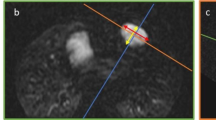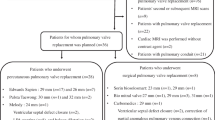Abstract
Introduction
Right ventricular (RV) dilatation is the determining prognostic factor in the long-term follow up of patients with repaired Tetralogy of Fallot (TOF). The objective of this study is to analyze whether the results vary depending on the timing of the complete repair and on the surgical technique applied.
Material–Methods
This is a retrospective longitudinal study in which patients with standard TOF were divided into 3 groups depending on their age at surgical repair: group 1 = Early repair (n = 12,1-8 months), group 2 = Late repair (n = 26, > 8 months), and group 3 = Late repair with previous palliative surgery (n = 17, > 8 months). Clinical, echocardiographic and cardiac magnetic resonance (CMR) data from patients that had received complete reparative surgery in our institution from January 2000 to March 2014 were analyzed and compared.
Results
55 patients with echocardiogram and CMR studies (13.39 ± 3.59 years) were reviewed. All patients had at least moderate pulmonary regurgitation (PR). We observed a positive correlation between PR and right ventricular end-diastolic volume (r2 = 0.418; p = 0,004). Group 3 had more severe right ventricular dilatation than patients in groups 1 and 2 (p = 0.001). No differences in right ventricular end-diastolic volume, PR, and pulmonary trunk dimensions were observed between groups 1 and 2. Patients in group 3 had a longer hospital stay.
Conclusions
Although all patients from our cohort had significant PR, age at surgery was not related to RV or pulmonary trunk dilatation. Previous palliative surgery was associated with more severe right ventricular dilatation and longer hospital stays. No differences were observed between early and late repair groups. Our study suggests that postponing TOF repair to a late stage does not improve the degree of PR or long-term morbidity from RV dilatation. Palliative surgery should be avoided if possible.


Similar content being viewed by others
Abbreviations
- BSA:
-
Body surface area
- CPB:
-
Cardiopulmonary bypass
- CMR:
-
Cardiac magnetic resonance
- ICD:
-
Implantable cardioverter defibrillator
- LV-EF:
-
Left ventricular ejection fractions
- RV-EF:
-
Right ventricle ejection fraction
- PR:
-
Pulmonary regurgitation
- RV:
-
Right ventricle
- RV-COi:
-
Right ventricular cardiac output index
- RV-EDV:
-
Right ventricle end-diastolic volume
- RV-ESV:
-
Right ventricular end-systolic volume
- RV-SVi:
-
Right ventricular stroke volume index
- TOF:
-
Tetralogy of Fallot
- VE:
-
Ventricular extrasystolia
- VT:
-
Ventricular tachycardia
References
Jonas RA (2009) Early primary repair of tetralogy of Fallot. Semin Thorac Cardiovasc Surg Pediatr Card Surg Annu. https://doi.org/10.1053/j.pcsu.2009.01.021
Al Habib HF, Jacobs JP, Mavroudis C et al (2010) Contemporary patterns of management of tetralogy of Fallot: data from the Society of Thoracic Surgeons Database. Ann Thorac Surg 90:813–819
Brown JW, Ruzmetov M, Vijay P et al (2007) Right ventricular outflow tract reconstruction with a polytetrafluoroethylene monocusp valve: a twelve-year experience. JThorac Cardiovasc Surg 133:1336–1343
Eyskens B, Brown SC, Claus P et al (2010) The influence of pulmonary regurgitation on regional right ventricular function in children after surgical repair or tetralogy of Fallot. Eur J Echocardiogr 11:341–345
Sarris GE, Comas JV, Tobota Z et al (2012) Results of reparative surgery for tetralogy of Fallot: data from the European Association for Cardio-Thoracic Surgery Congenital database. Eur J Cardiothorac Surg 42:766–774
Bautista-Hernandez V, Cardenas I, Martinez-Bendayan I et al (2013) Valve-sparing tetralogy of Fallot repair with intraoperative dilatation of the pulmonary valve. Pediatr Cardiol 34:918–923
Hua Z, Li S, Wang L et al (2011) A new pulmonary valve cups plasty technique markedly decreases transannular patch rate and improves mid-term outcomes of tetralogy of Fallot repair. Eur J Cardiothorac Surg 40:1221–1226
Pozzi M, Trivedi DB, Kitchiner D, Arnold RA (2000) Tetralogy of Fallot: what operation, at which age. Eur J Cardiothorac Surg 17(6):631–636
Geva T (2011) Repaired tetralogy of Fallot: the roles of cardiovascular magnetic resonance in evaluating pathophysiology and for pulmonary valve replacement decision support. J Cardiovasc Magn Reson 13:9
Villafañe J, Feinstein JA, Jenkins KJ et al (2013) Hot topics in tetralogy of Fallot. J Am Coll Cardiol 62:2155–2166
DuBois D, DuBois EF (1916) A formula to estimate the approximate surface area if height and weight be known. Arch Intern Med 17:863–871
Sarikouch S, Peters B, Gutberlet M (2010) Sex-specific pediatric percentiles for ventricular size and mass as reference values for cardiac MRI. Circ Cardiovasc Imaging 3:65–76
Pettersen MD, Du W, Skeens ME et al (2008) Regression equations for calculation of z scores of cardiac structures in a large cohort of healthy infants, children, and adolescents: an echocardiographic study. Am Soc Echocardiogr 21:922–934
van der Hulst AE, Hylkema MG, Vliegen HW, Delgado V, Hazekamp MG, Rijlaarsdam ME et al (2012) Mild residual pulmonary stenosis in tetralogy of Fallot reduces risk of pulmonary valve replacement. Ann Thorac Surg 94(6):2077–2082
Yang S, Wen L, Tao S, Gu J, Han J et al (2019) Impact of timing on in-patient outcomes of complete repair of tetralogy of Fallot in infancy: an analysis of the United States National Inpatient 2005–2011 database. BMC Cardiovasc Disord 19(1):46
Cunningham ME, Donofrio MT, Peer SM, Zurakowski D, Jonas RA, Sinha P (2017) Optimal timing for elective early primary repair of tetralogy of Fallot: analysis of intermediate term outcomes. Ann Thorac Surg 103(3):845–852
Laudito A, Bandisode VM, Lucas JF (2006) Right ventricular outflow tract stent as a bridge to surgery in a premature infant with tetralogy of Fallot. Ann Thorac Surg 81:744–746
Dirks V, Pretre R, Knirsh W et al (2013) Modified Blalock-Taussig shunt: a not-so-simple palliative procedure. Eur J Cardiothorac Surg 44:1096–1102
Barron DJ (2013) Tetralogy of Fallot: controversies in early management. World J Pediatr Congenital Heart Surg 4:186–191
Knauth AL, Gauvreau K, Powell AJ (2008) Ventricular size and function assessed by cardiac MRI predict major adverse clinical outcomes late after tetralogy of Fallot repair. Heart 94:211–216
Gatzoulis MA, Balaji S, Webber SA (2000) Risk factors for arrhythmia and sudden cardiac death late after repair of tetralogy of Fallot: a multicentre study. Lancet 356:975–981
Khairy P, Aboulhosn J, Gurvitz MZ (2010) Arrhythmia burden in adults with surgically repaired tetralogy of Fallot: a multi-institutional study. Circulation 122:868–875
Hamada H, Terai M, Jibiki T (2002) Influence of early repair of tetralogy of Fallot without an outflow patch on late arrhythmias and sudden death: a 27-year follow-up study following a uniform surgical approach. Cardiol Young 12:345–351
Valente AM, Gauvreau K, Babu-Narayan SV et al (2011) Ventricular size and function measured by cardiac MRI improve prediction of major adverse clinical outcomes independent of prolonged QRS duration in patients with repaired tetralogy of Fallot (abstr). Circulation 124:A11414
Buechel V, Dave HH, Kellenberger CJ et al (2005) Remodeling of the right ventricle after early pulmonary valve replacement in children with repaired tetralogy of Fallot: assessment by cardiovascular magnetic resonance. Eur Heart J 26:2721–2727
Brown JW, Ruzmetov M, Vijay P et al (2007) Right ventricular outflow tract reconstruction with a polytetrafluoroethylene monocusp valve: a twelve-year experience. J Thorac Cardiovasc Surg 133:1336–1343
Zaidi C, Cossor W, Singh A et al (2018) Three-dimensional analysis of regional right ventricular shape and function in repaired tetralogy of Fallot using cardiovascular magnetic resonance. Clin Imaging 52:106–112
Davlouros PT, Kilner PJ, Hornung TS (2002) Right ventricular function in adults with repaired tetralogy of Fallot assessed with cardiovascular magnetic resonance imaging: detrimental role of right ventricular aneurysms or akinesia and adverse right-to-left ventricular interaction. J Am Coll Cardiol 40:2044–2052
Tamesberger MI, Lechner E, Mair R (2008) Early primary repair of tetralogy of Fallot in neonates and infants less than four months of age. Ann Thorac Surg 86:1928–1936
Loomba R, Buelow M, Woods R (2017) Complete repair of tetralogy of Fallot in the neonatal versus non-neonatal period: a meta-analysis. Pediatr Cardio 38:893–901
Hickey E, Veldtman G, Bradley TJ et al (2009) Late risk of outcomes for adults with repaired tetralogy of Fallot from an inception cohort spanning four decades. Eur J Cardiothorac Surg 35:156–164
Author information
Authors and Affiliations
Corresponding author
Ethics declarations
Conflict of interest
Authors declare no conflicts of interest and compliance with Ethical Standards and the Ethical Approval.
Additional information
Publisher's Note
Springer Nature remains neutral with regard to jurisdictional claims in published maps and institutional affiliations.
Rights and permissions
About this article
Cite this article
Clemente, E.A., Casares, Á.P., Frontera, P.R. et al. Finding the Optimal Timing for Repair of Standard Tetralogy of Fallot: Analysis of Cardiac Magnetic Resonance and Echocardiography Parameters Related to Intermediate Term Outcomes in a Pediatric Population. Pediatr Cardiol 42, 1324–1333 (2021). https://doi.org/10.1007/s00246-021-02615-z
Received:
Accepted:
Published:
Issue Date:
DOI: https://doi.org/10.1007/s00246-021-02615-z




